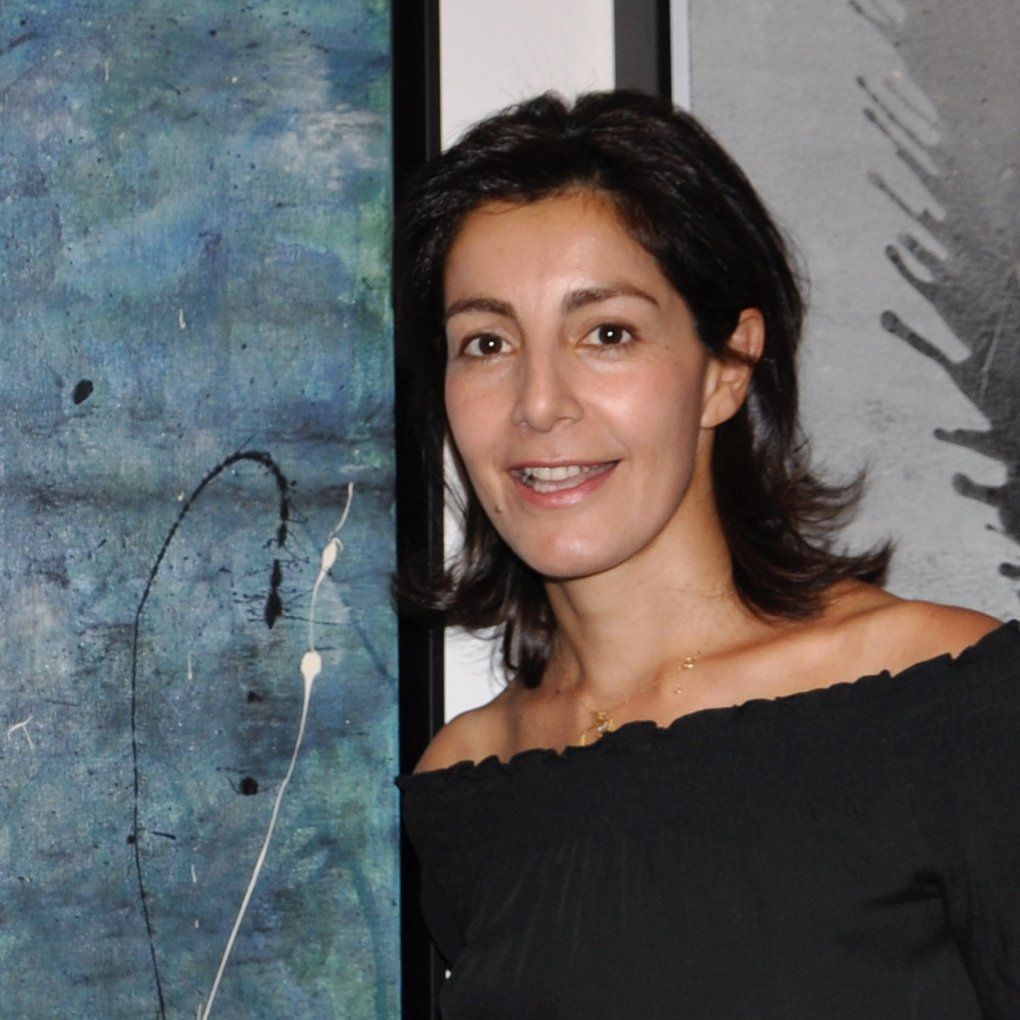Iranian-born artists often signpost their culture in the artworks that they create. They cover their canvases with Persian calligraphy, replicate motifs found in ancient miniatures, and represent women cloaked in the chador. Azadeh Ghotbi takes a different route: abstraction. Yet her works are no less connected to her country of origin.
Azadeh left Iran when she was a little girl of nine. She moved to Paris with her family, then to the U.S., and now lives and works in London. Still, her attachment to the homeland remains astonishingly strong.
“Revolution, loss, exile and the idiosyncracies of being stateless yet feeling proud of one’s heritage marked the early part of my life,” she writes on her website. “I left my country at an age when one is too young to fully comprehend the magnitude of the situation, yet old enough to be scarred by its consequences.”

We meet in her elegantly furnished London living room (a floor above her atelier). Walls are covered with large, elegant canvases that show interlocking patterns in subdued tones of beige, grey, blue and green. Neither portraits nor landscapes, they are subtle manifestations of her states of mind.
Azadeh was exposed to culture from a young age, going to museums often, listening to music, and watching performances of theater and dance. Yet her parents (Reza and Shahrzad Ghotbi) instilled in her and her brother the importance of studiousness and academic excellence. As a result, her artistic streak remained dormant until early adulthood.
“It never occurred to me to do art,” she recalls. “I thought subliminally that one has to have an office job, go to an Ivy League school, study well, do something that has to do with books and brains – and that art was something for Sunday.”
Azadeh attended an Ivy League school – Brown University, where she studied International Relations – then got her MBA from the elite INSEAD business school near Paris.
She was awakened to the wonders of painting by an art history class at Brown. One day, a visiting lecturer specializing in Jackson Pollock (the Abstract Expressionist painter) addressed her class. He gave what seemed to be far-fetched, Freudian interpretations of his art. Azadeh silently questioned those interpretations, and decided to investigate.
“Something in that class triggered an urge and a need to, in hiding, just for myself, go and try it out,” she explains. “For the first time in my life, I actually wanted to experiment. It was very intuitive and raw.”
With no prior art training, she bought canvases and brushes and started to paint. It was a beautiful, sunny day, and she was in a cheery mood. But “I went outside and painted really quite macabre things” – to prove that artists could mislead the viewer about their psychological mindset. She even stuck a dead bug on the surface of the painting. That first artwork was shocking and even worrying to friends who saw it. But through it, “I got hooked on painting.”
After her MBA, Azadeh held several office jobs: as a telecoms consultant in Boston, then a marketing executive for L’Oreal (in France and the U.S.) Yet art slowly started taking over her life.
“Some people go do drugs: I painted,” she explains. “I would paint on weekends. I would paint whenever I had time, and then hide the paintings, put them in the bedroom. At some point, I literally ran out of space, so I started putting them on my walls. But nobody knew they were by me.”
A private art dealer who sensed that the paintings were by Azadeh asked her to contribute a few to a charity auction at the Asia Society in New York. When her painting came up, the previously lifeless room suddenly swung into gear. “Before I knew it, my painting, which nobody had seen – my own parents didn’t know I was painting – drew the highest bid at that auction until that moment. It was a permission to come out of the closet.”
Azadeh is now an established international artist who has shown in Los Angeles, Amsterdam and Frankfurt but also Dubai, Cairo and Tehran.
Still, humility remains one of her defining characteristics. “I still am uncomfortable sometimes saying ‘I’m an artist,’” she says. “To me, it’s a title others give to you.”

Abstract though it is, Azadeh’s art frequently channels profound personal feelings about the distance between her and her homeland. In the “Twisted Tales” series, she paints a large canvas on two sides, then cuts it up in shreds and puts it back together, with ribbon-like strips of two-sided canvas sagging from the surface. “We have this unique sculptural demonstration of what a very distressed life that has been put back together can look like,” she explains. “I want to show that sometimes these kinds of lives make for something much more beautiful, complex and interesting.”
Living in London fills her with joy. “I love this city: the diversity of the people, the incredible opportunities that it has, the can-do attitude. It’s such a privilege to have the best galleries and the best exhibits coming my way.”
Yet the country she still calls home is Iran.
“It’s part of my DNA,” she insists. “It’s in me whether I like it or not, and I actually like it. It’s my culture, it’s my background, it’s who I am. Every day that goes by, a little bit less of me, quantifiably, is Iranian, because I’ve spent an even smaller percentage of my life living there. But with age and time spent way, I actually am even more curious to learn more about it. It’s like catching up for not having been there.”


